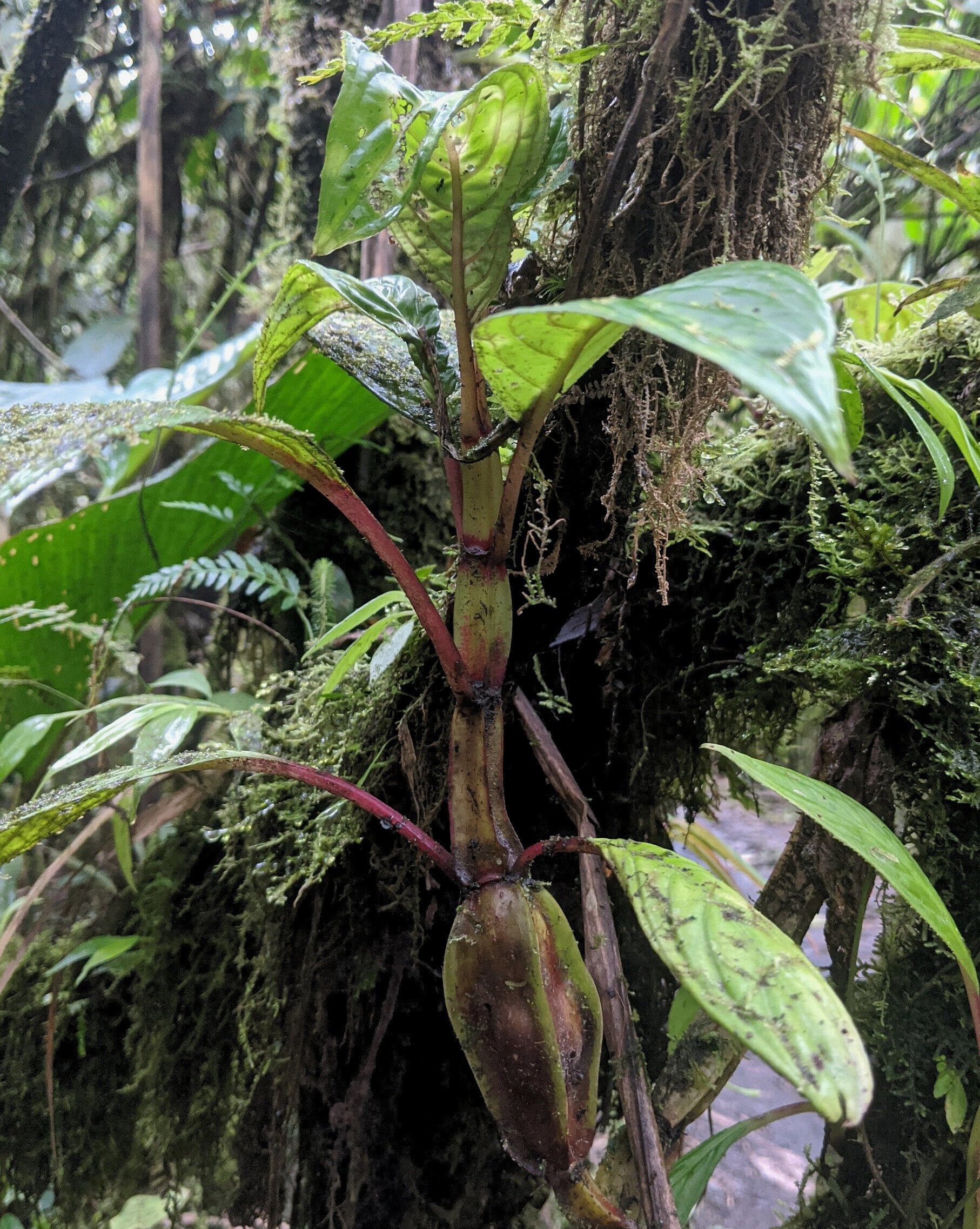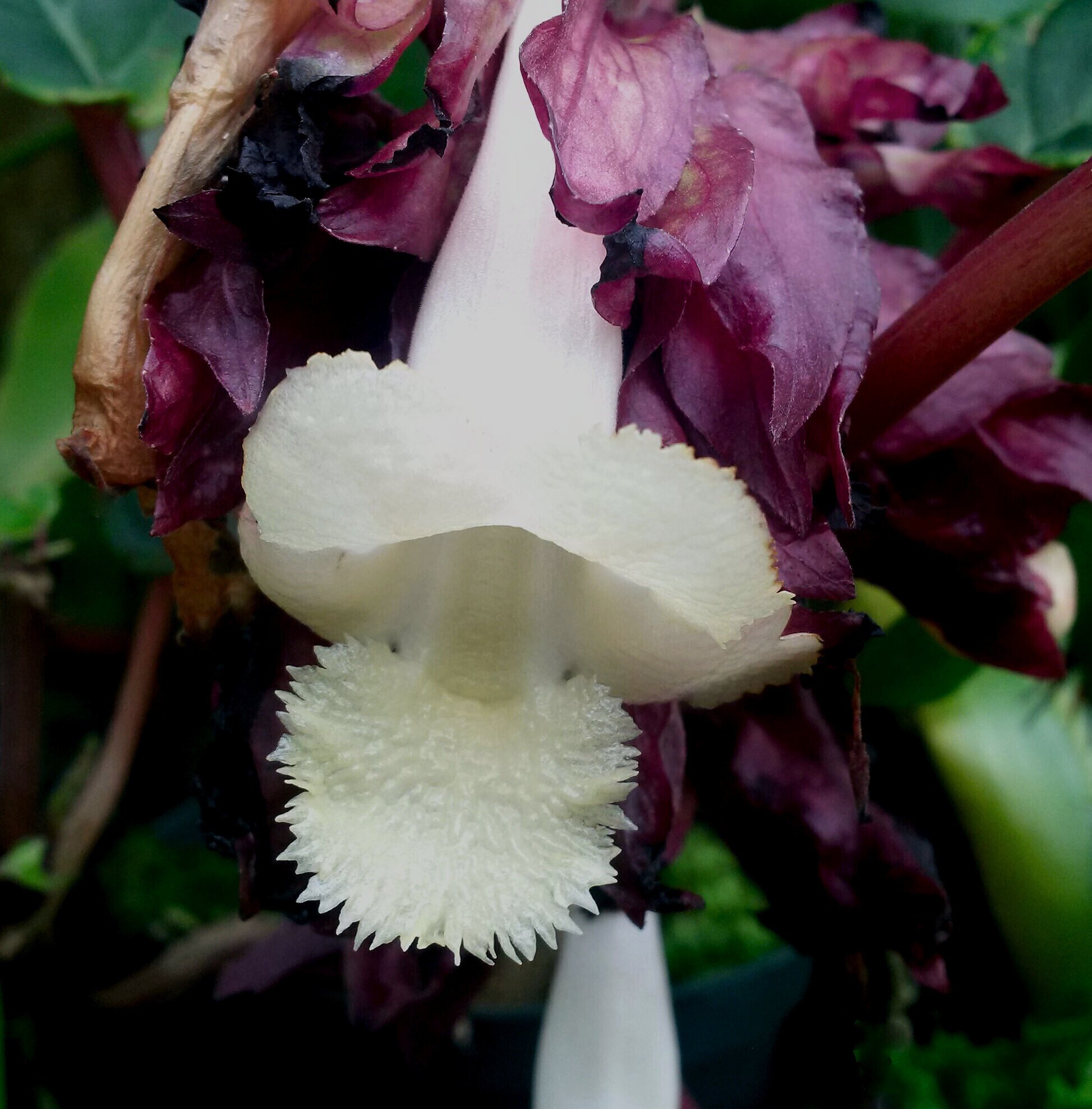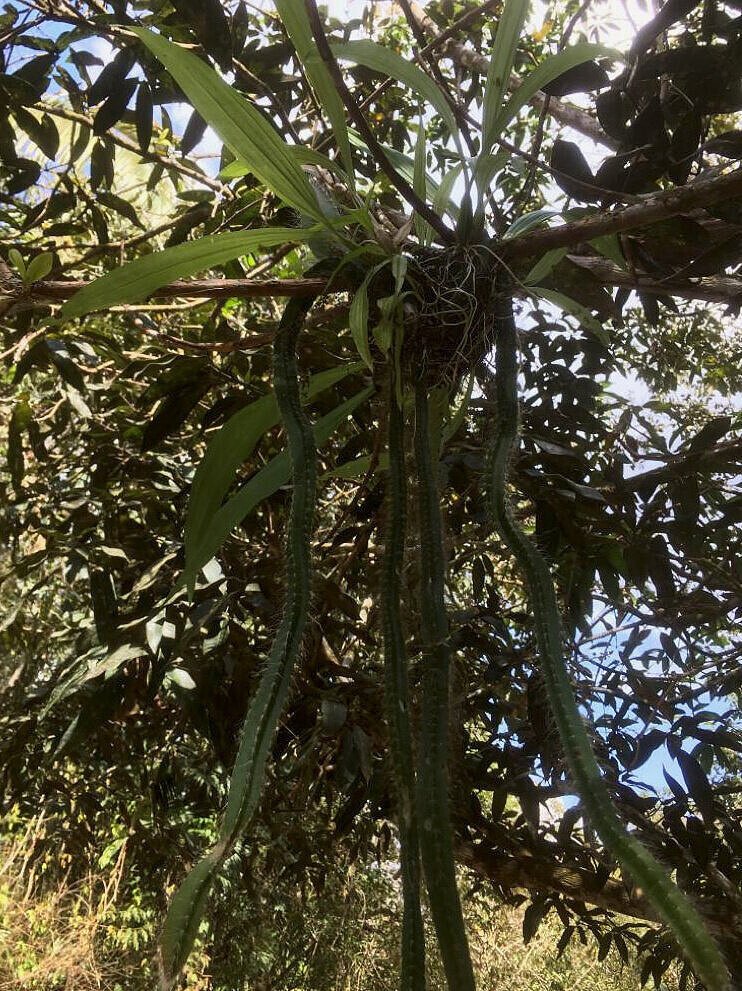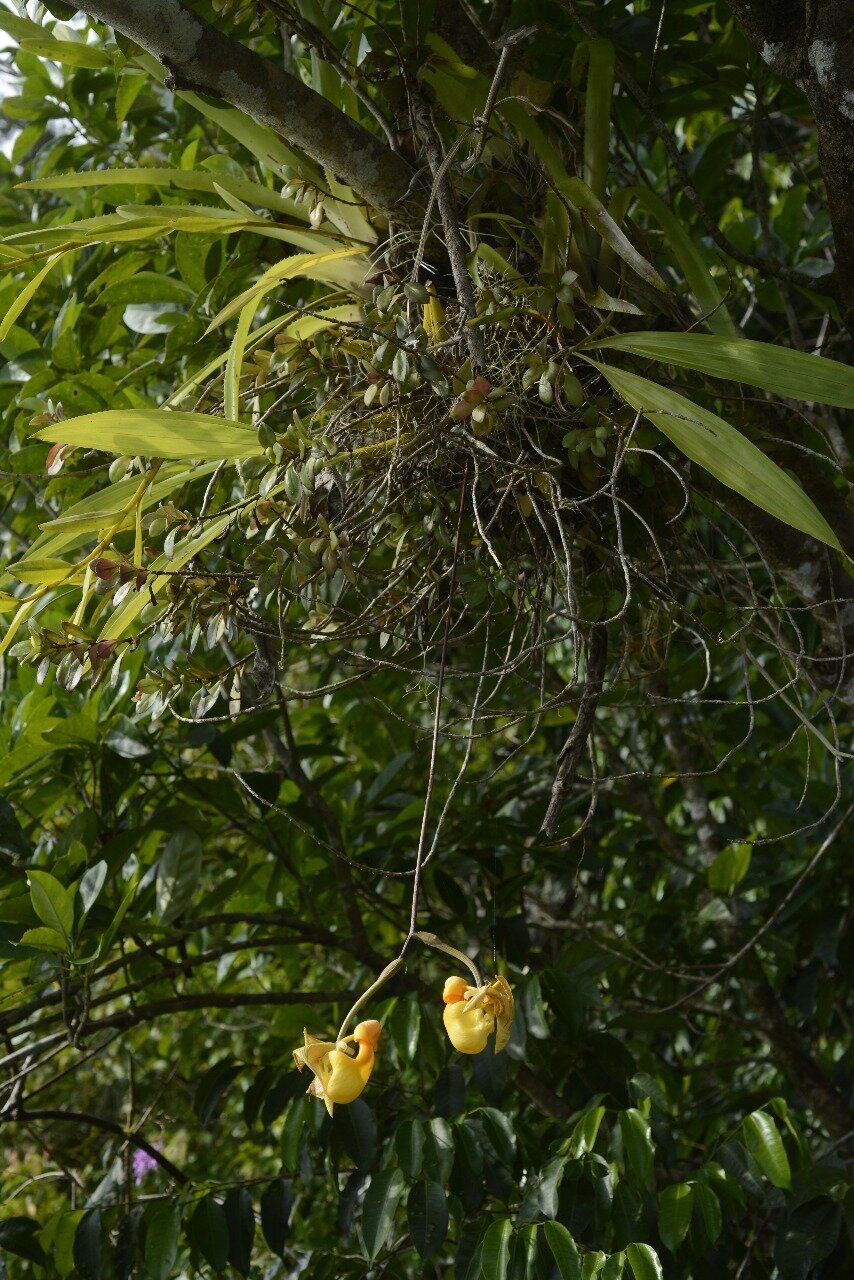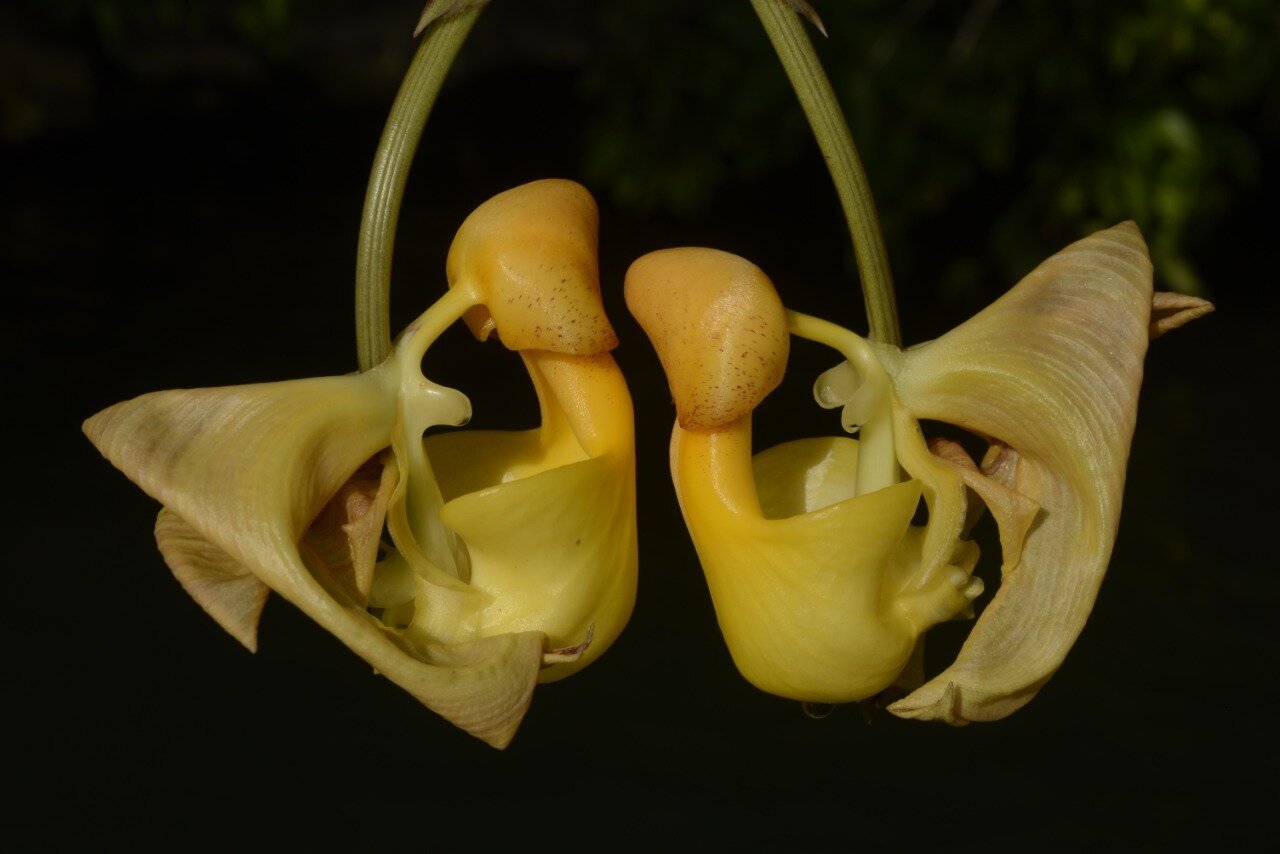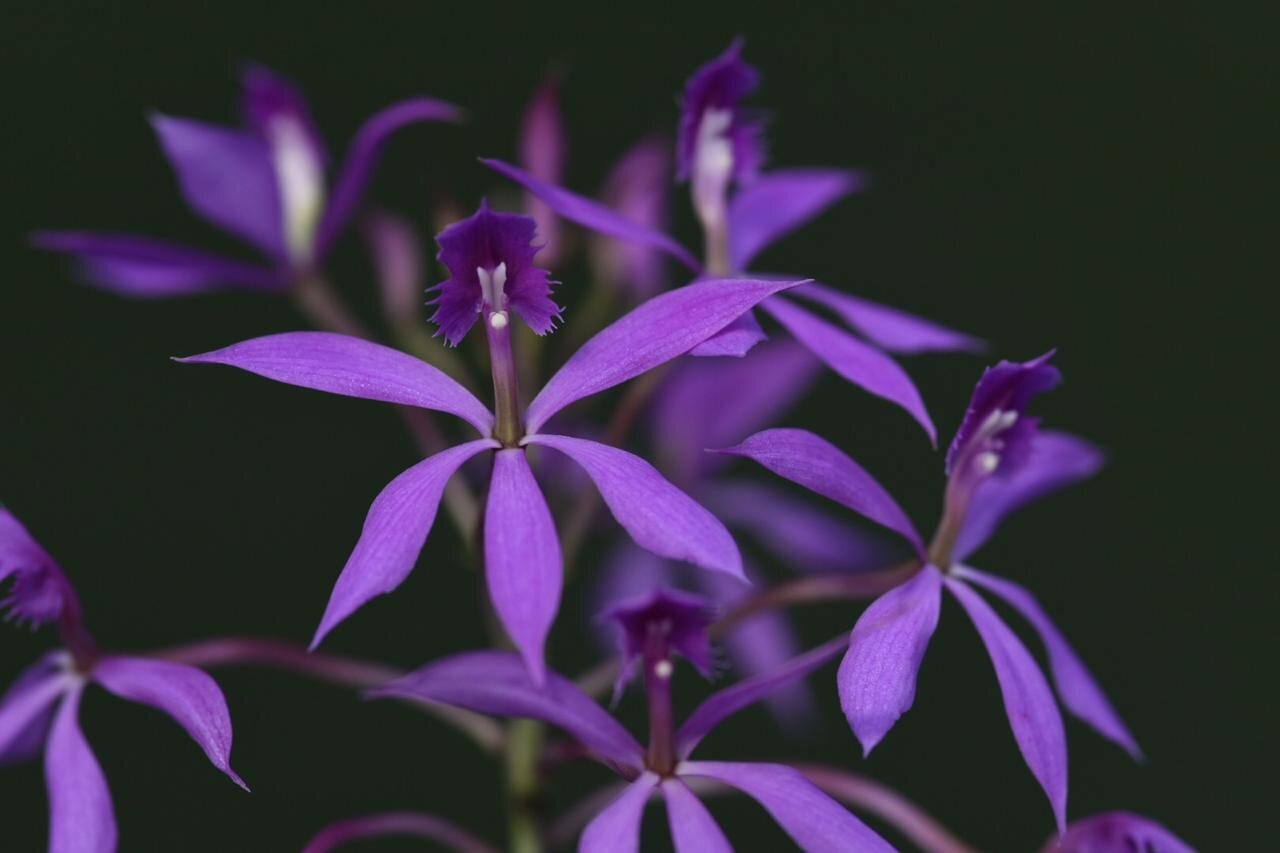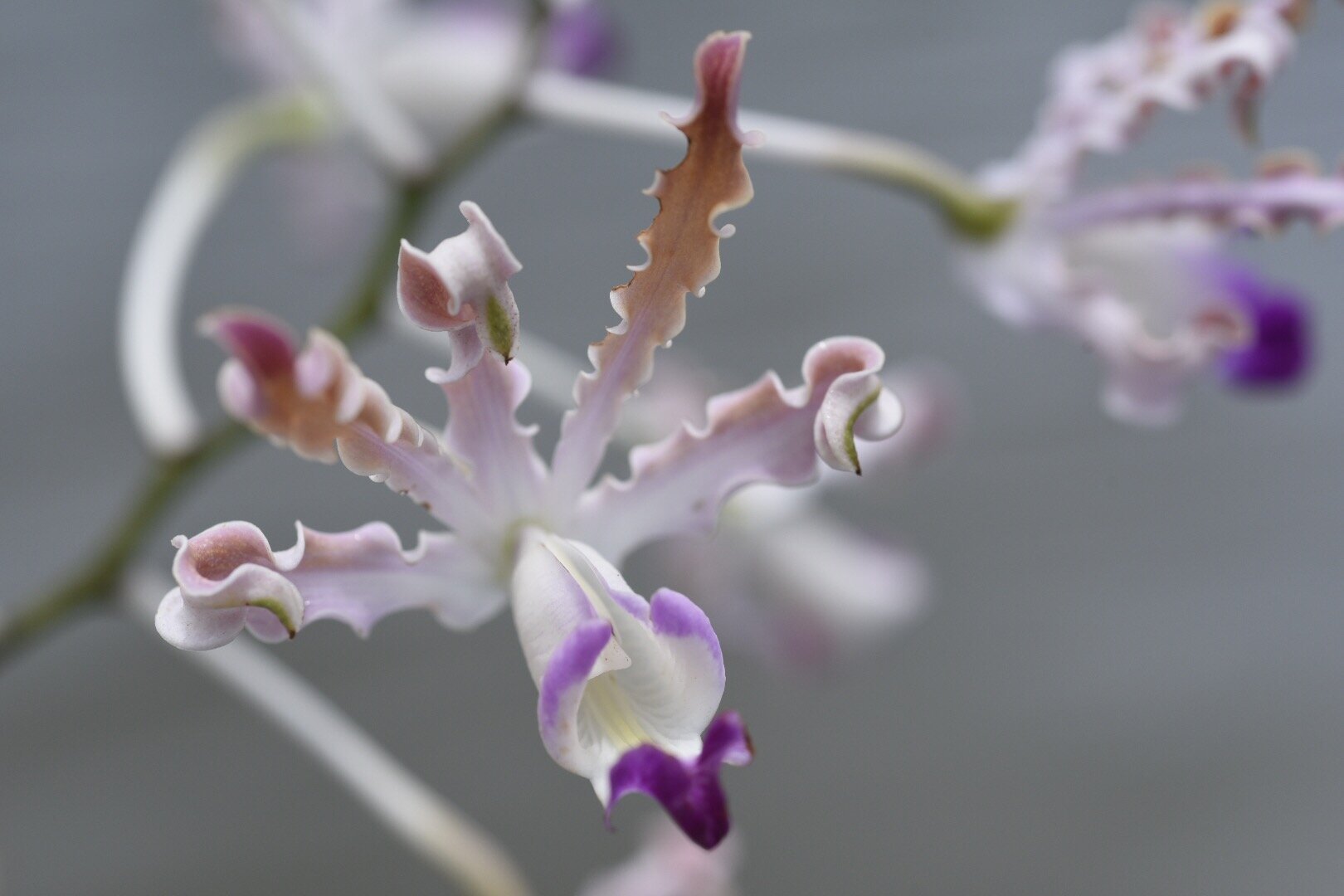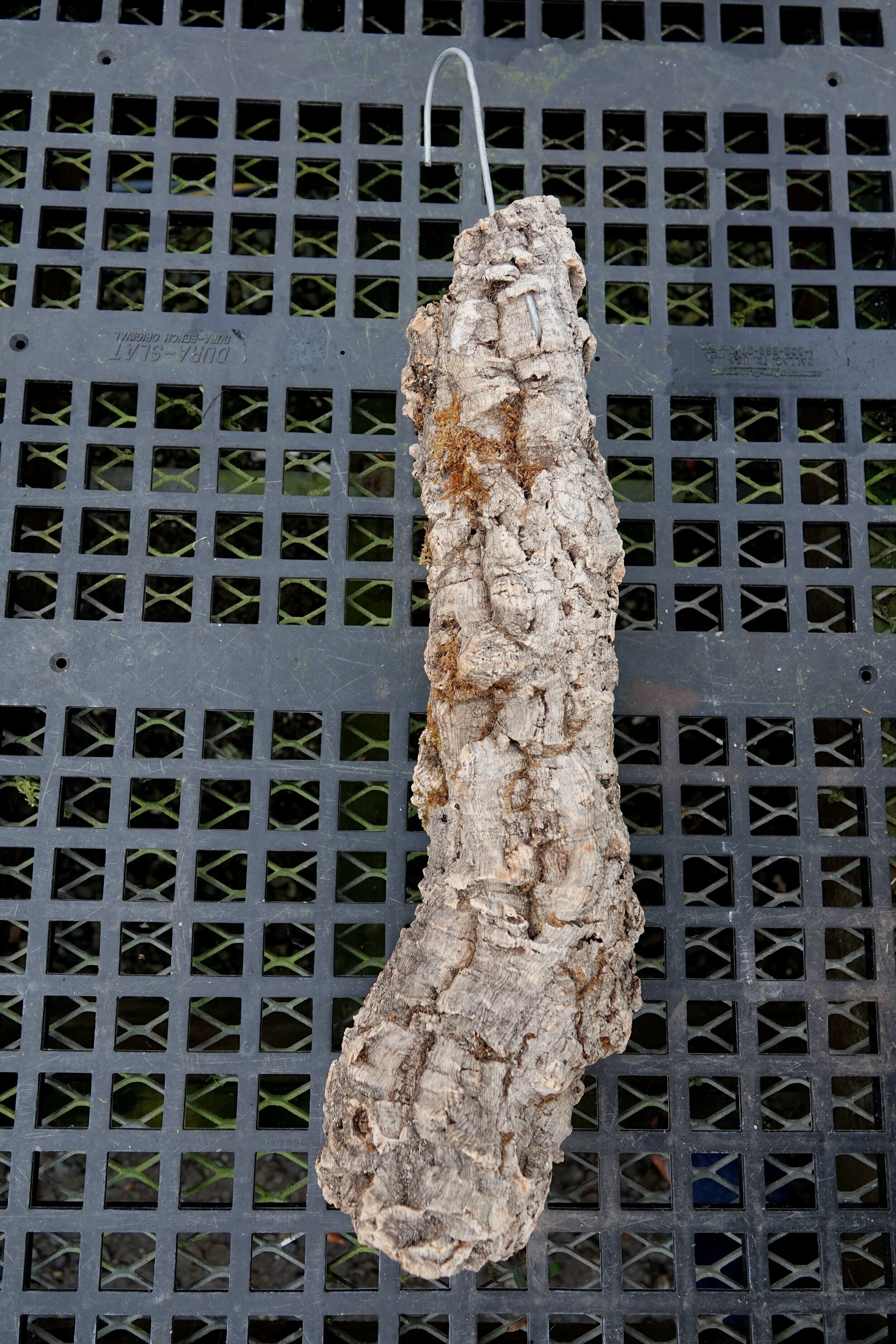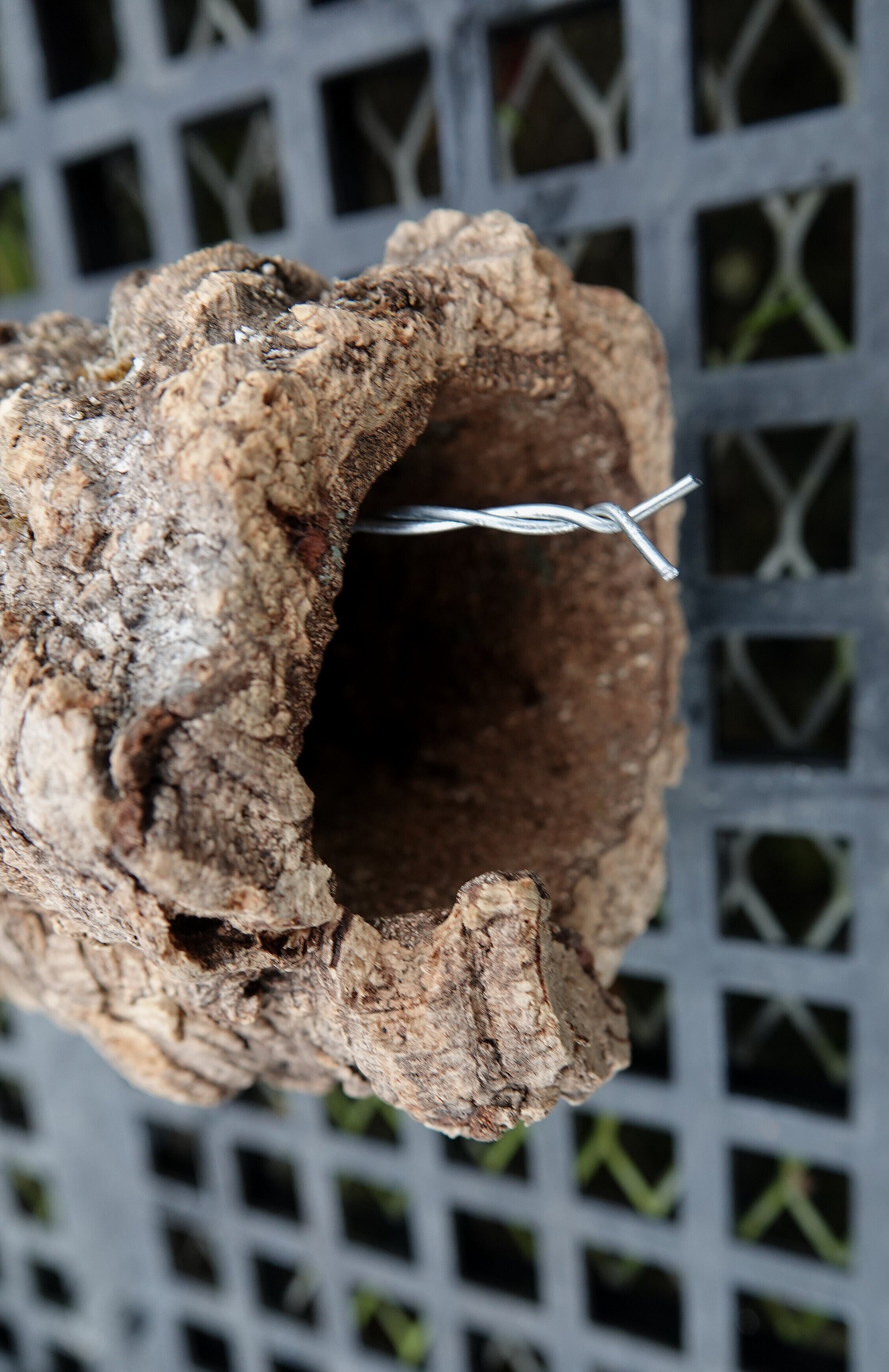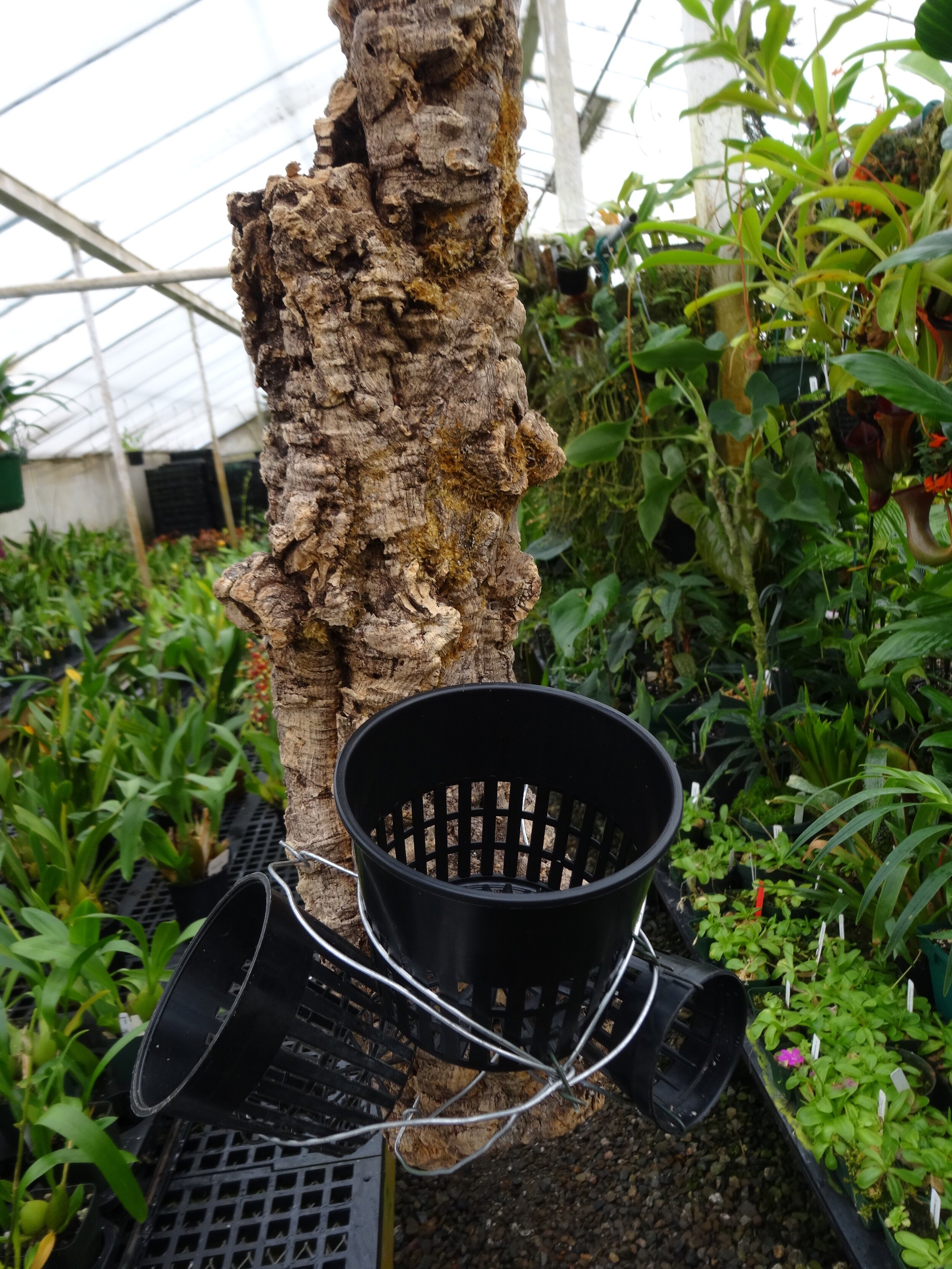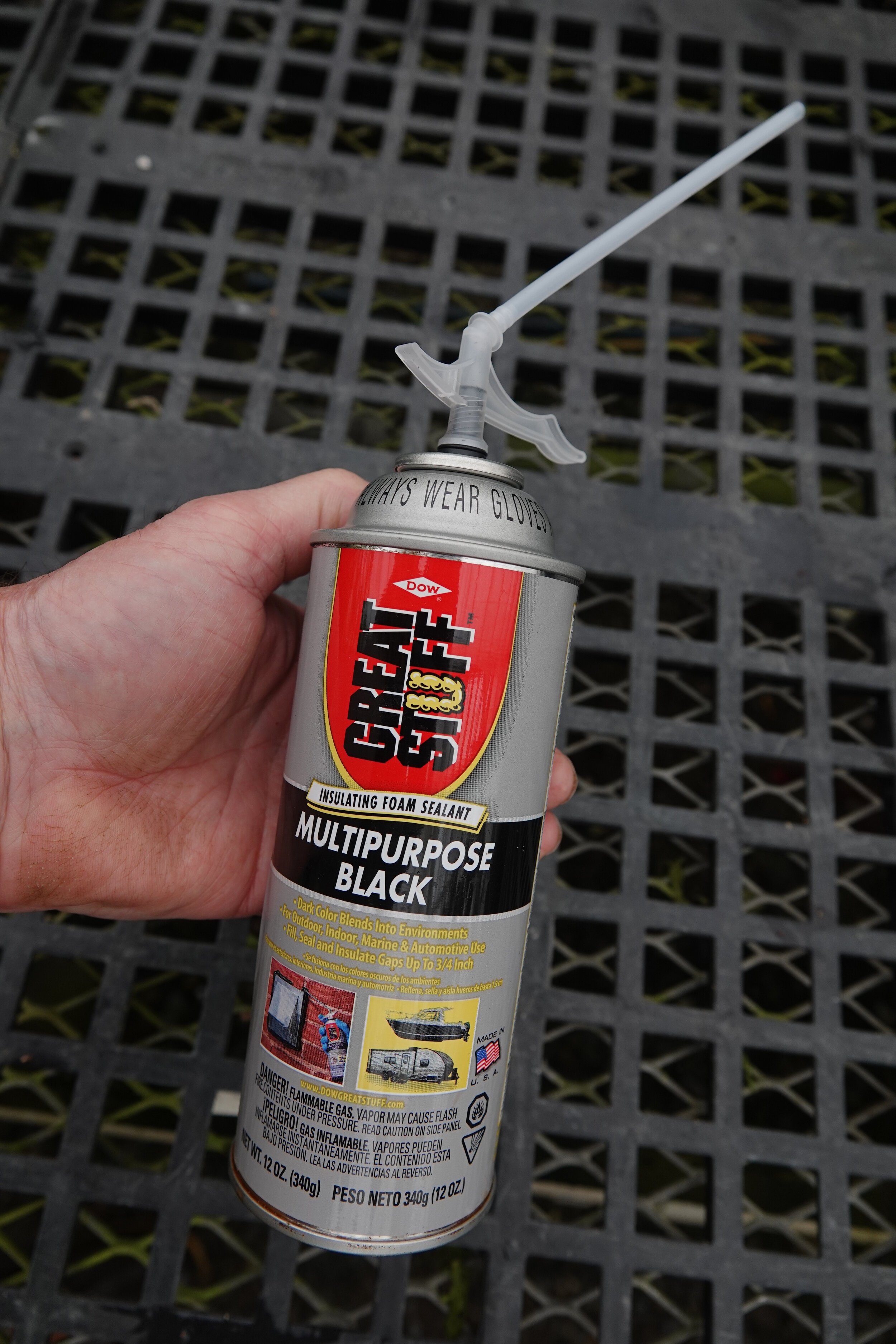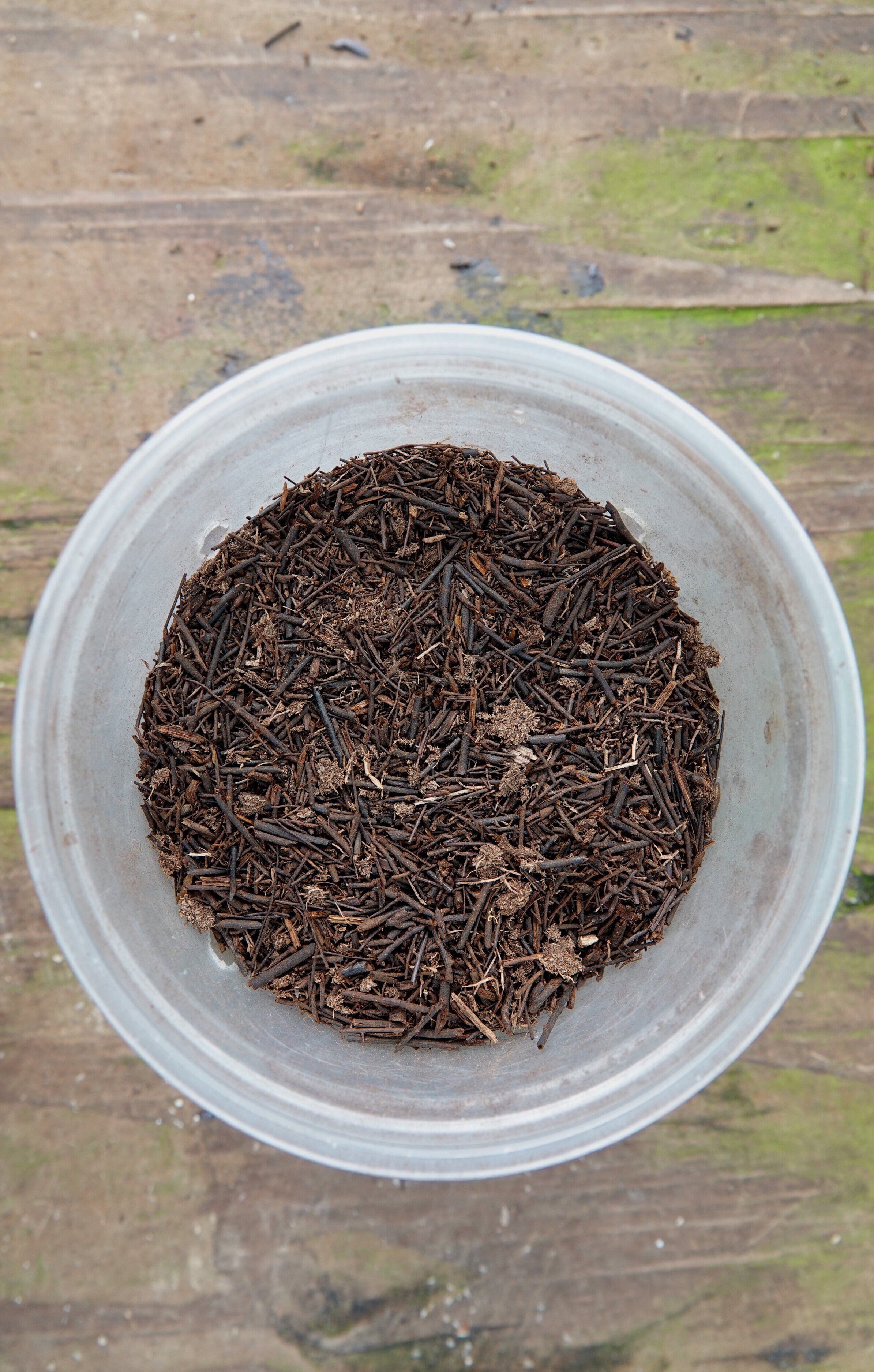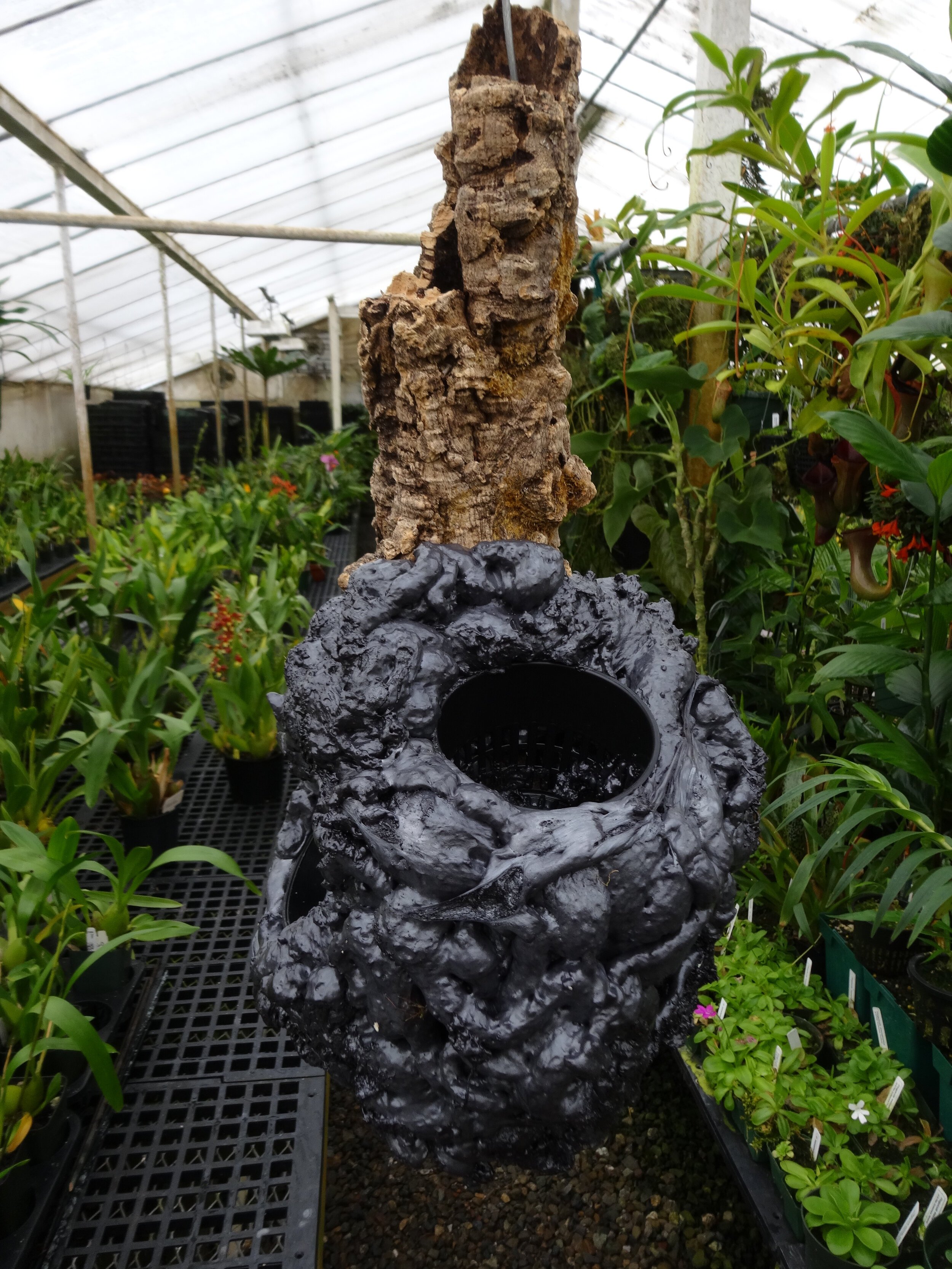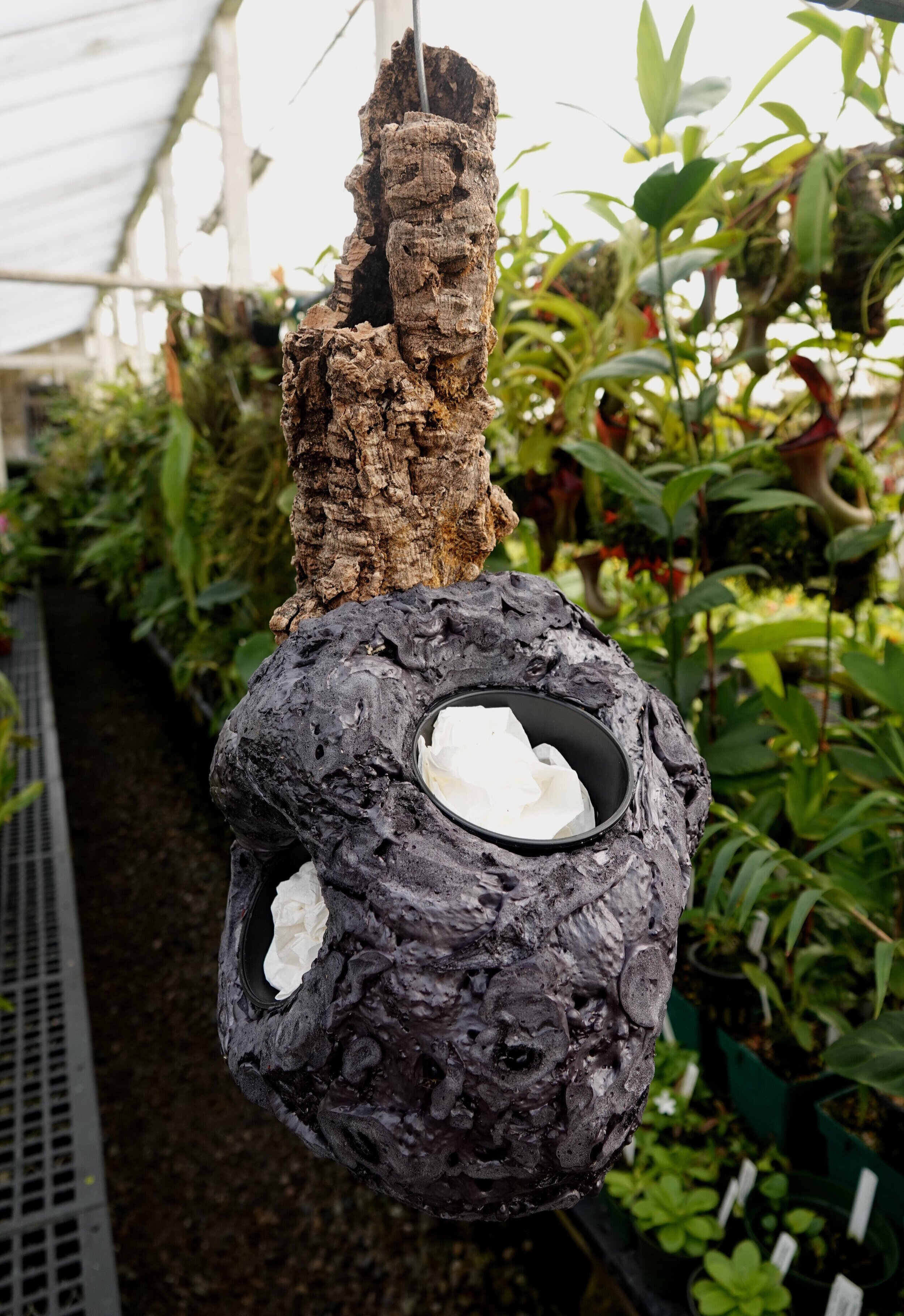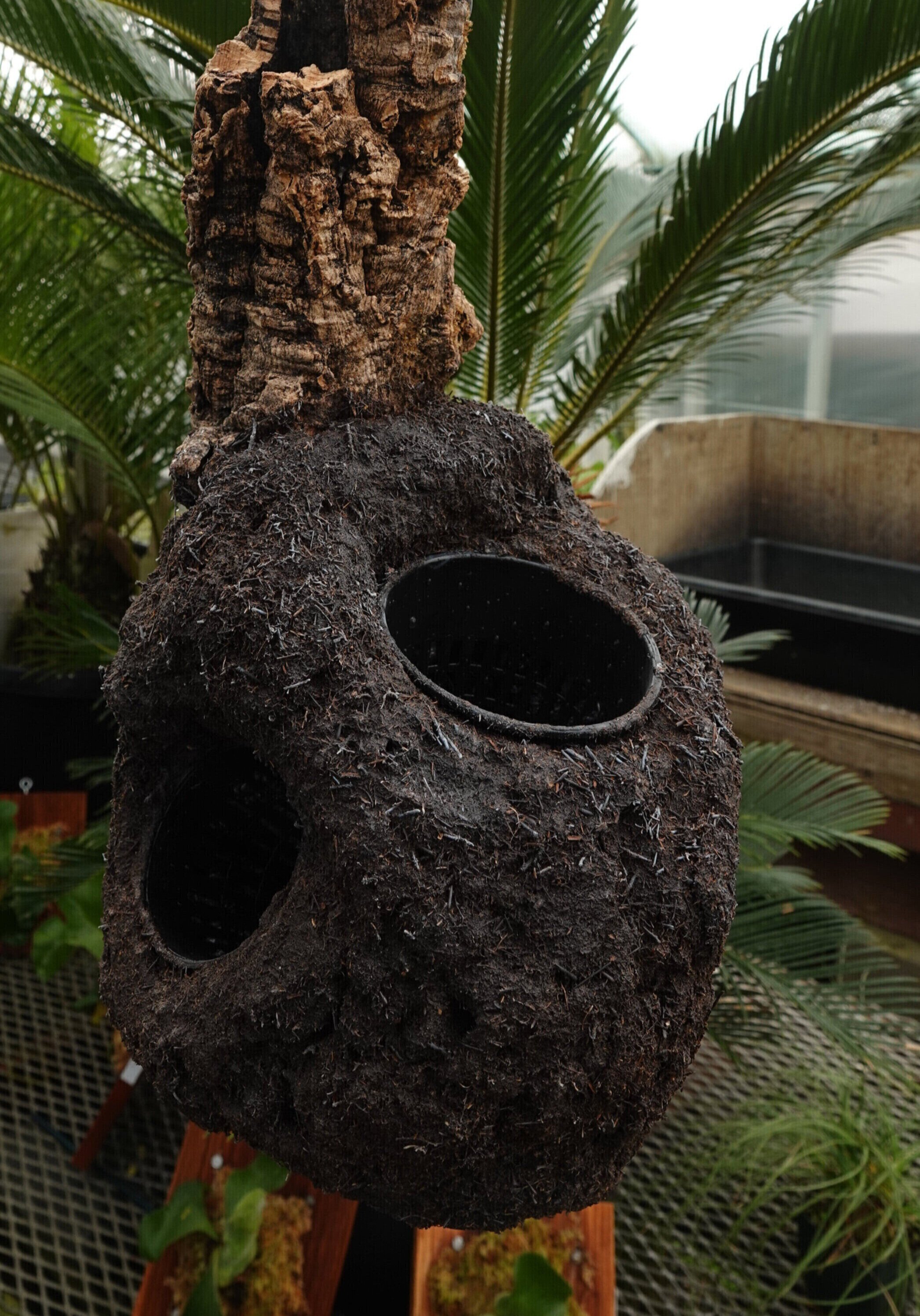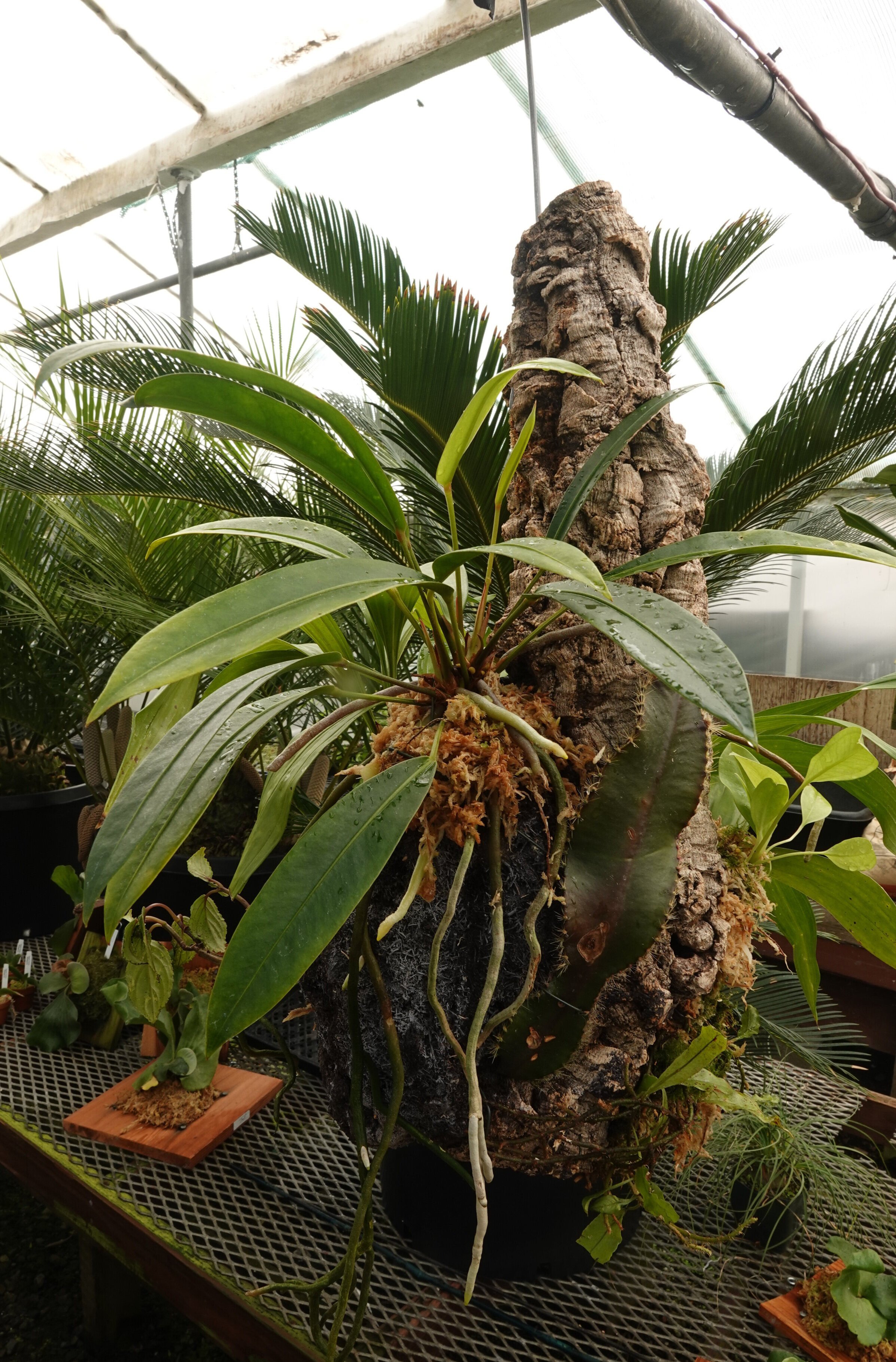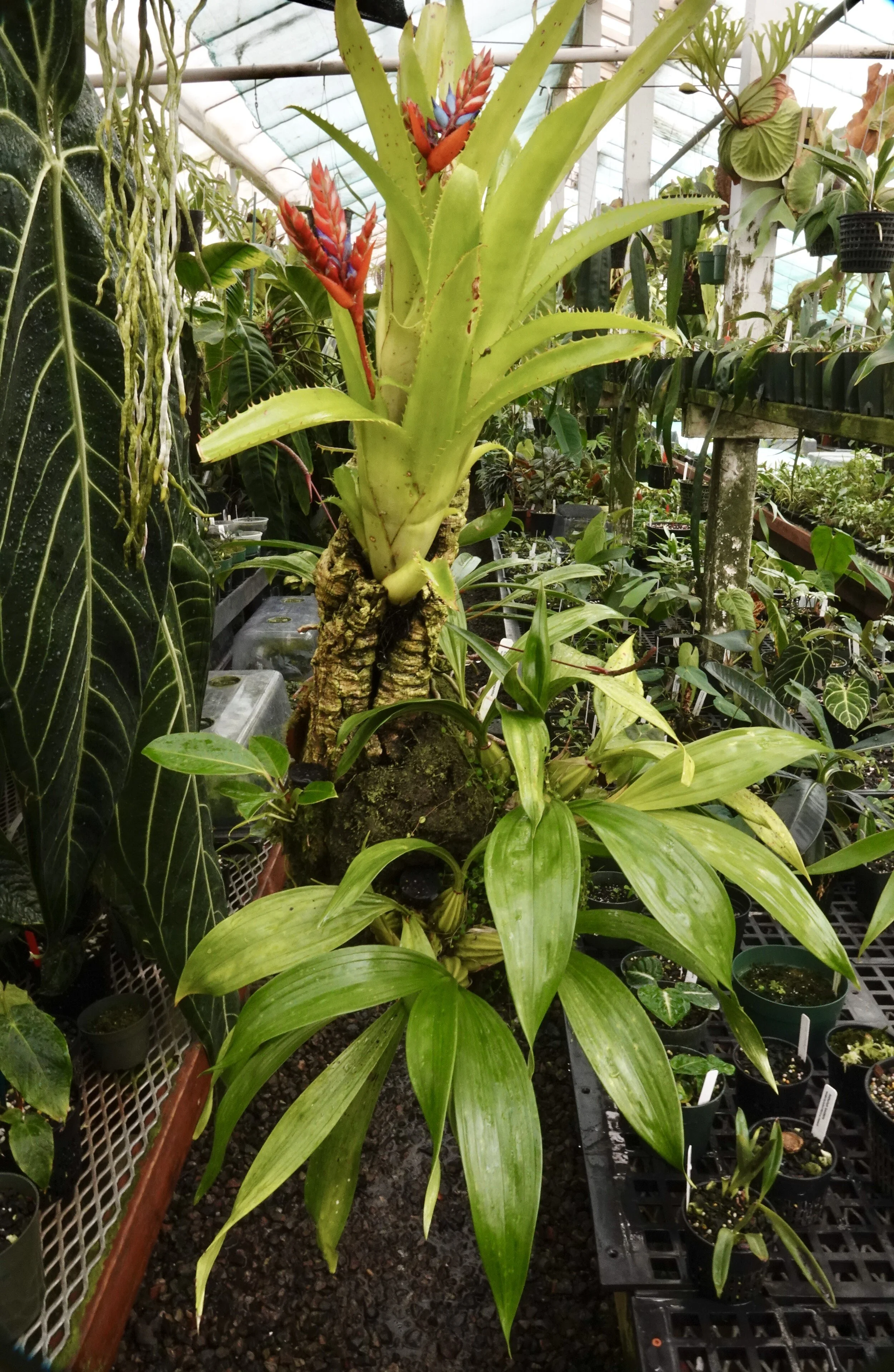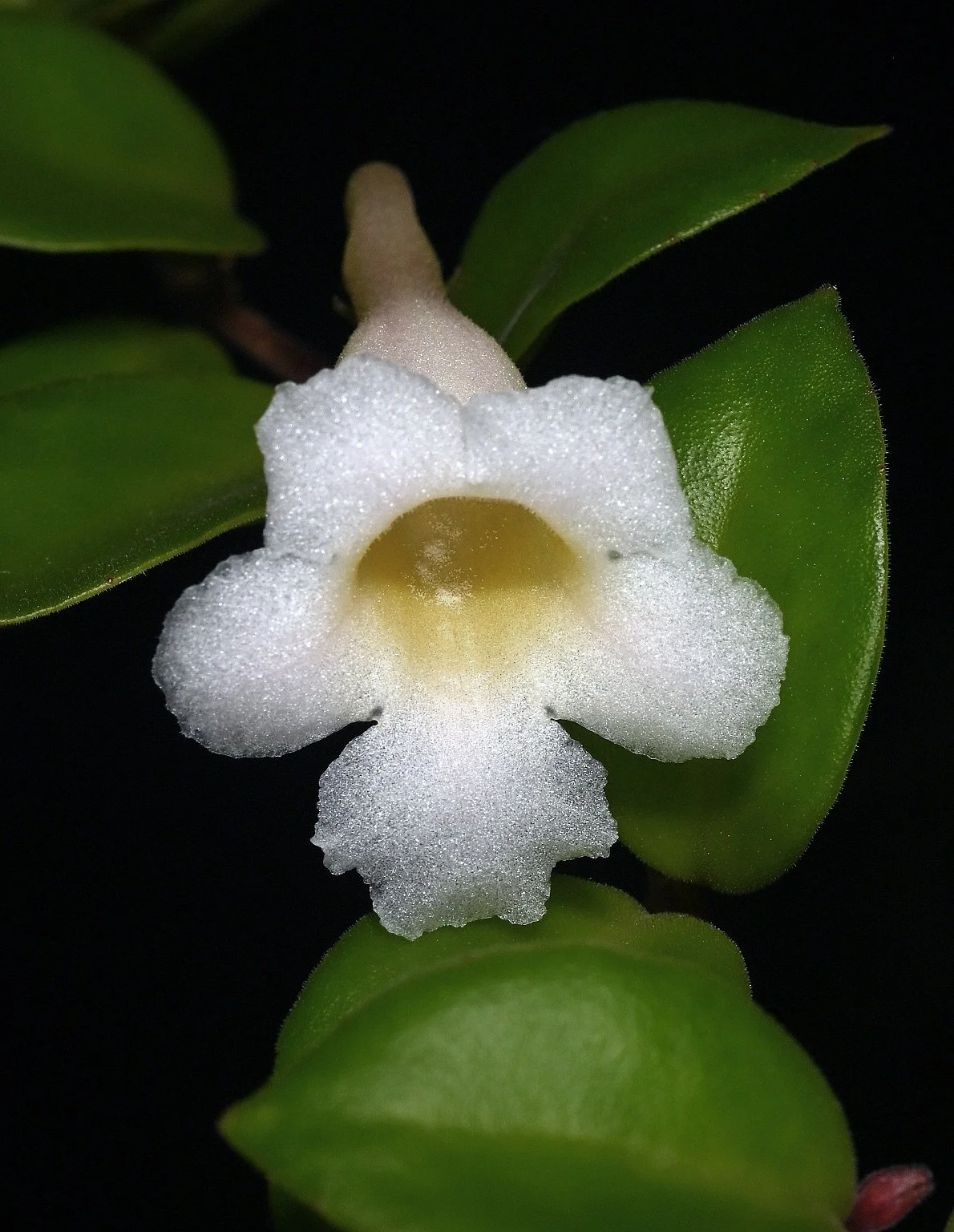Ants in my plants?
Neotropical Ant Gardens & A Tutorial For Building A Display
by Jay Vannini
A large arboreal ant garden growing in riparian lowland rainforest of eastern Guatemala. Conspicuous myrmecophilous plants include Aechmea tillandsioides, Coryanthes picturata, and Codonanthopsis macradenia. Image: ©F. Muller 2019.
Ant-plant mutualisms (often included under the broader term “myrmecophily” = a symbiotic relationship with ants) are ubiquitous throughout the world, albeit with widely varying degrees of collaboration evident between the two parties. Many plant families have species that have evolved simple to very elaborate adaptations to benefit from these relationships. These range from the production of olfactory lures, floral and extrafloral nectaries as well as Beltian and pearl bodies to attract and reward their ant stewards, through to provision of hollow stems and onto very complex chambered domatia (chambers) that facilitate colonization of the plants’ stems by defensive ants.
Ant garden in lowland tropical rainforest, Samar Island, Philippines. Shown are young examples of Myrmecodia tuberosa var. sibuyanensis and Dischida cleistantha. Image: ©R. Parsons 2019.
In Southeast Asia, throughout Malesia on to northeastern Australia and some of the islands of the western Pacific, epiphytic communities involving a plant guild and several genera of ants but especially Philidris and Camponotus (Dolichoderinae), are sometimes referred to as “ant gardens”. These communities usually consist of at least one species of each of the following genera: an orchid (Dendrobium), and rubiaceous ant plant (Hydnophytum or Myrmecodia), dogbanes (Dischidia or Hoya), a fern (Lecanopteris, Drynaria or Asplenium), a melastome (Pachycentria or Medinilla) and sometimes a mistletoe (Loranthaceae). Probably because most of these plants will develop caudexes or specialized leaves that provide housing for ants (domatia), conspicuous ant cartons appear to be rare in these communities in the Old World.
While less widely known, ant gardens are also prevalent in lowland wet forests throughout the Neotropics, on or directly adjacent to arboreal, carton-type ant nests. These plant communities may involve a wide variety of plant families as well and are now known to be far more species-diverse than their Old World counterparts. Some ant gardens have been documented to exceed 3’/90 cm in diameter in parts of Amazonian Perú and 5’/1.55 m in Costa Rica. In northern Mesoamerica, ant gardens are usually somewhat smaller than this, although I have also encountered arboreal ant nests on tree trunks in tropical forests of northern Guatemala and colonized by ferns and gesneriads that approached 3’/90 cm in length and Fred Muller has found even larger ant gardens in Guatemala’s eastern tropical lowlands.
A fairly basic ant garden in lowland wet forest of central Guatemala. The orchid Catasetum integerrimum and a snakefern, Microgramma lycopidioides, growing on a coyol palm, Acrocomia aculeata. Image: ©F. Muller 2019.
Neotropical ant gardens remain one of the least studied of all ant-plant relationships. While most tropical American ant gardens involve carton type nests built by advanced ant species that, due to high caloric diets, have the ability to assemble these often imposing structures, others make use of dense root structures or hollow plant stems to use as a communal anchor (Benzing, 1991). Indeed, many Neotropical ant gardens are parabiotic with regard to both ants and plants, as well as other organisms that inhabit/parasitize/frequent these communities.
Carton type nests begin as a foundation cast around young root masses as ants add soil or sand grains, vertebrate fecal particles, decomposing wood fragments and plant debris, which is then embedded in adhesive, carton-forming substances regurgitated by the ants (Benzing, 1991). The resultant blend is a fertile, light matrix that is an excellent substrate for plants to grow in. Associated myrmecophytes provide a number of benefits to the ants, including pearl bodies, fruits, floral and extrafloral nectars, and much improved structural integrity to the nest as root masses penetrate deep throughout the carton and onto surrounding branches. There is also evidence that the often-dense canopy provided by ant garden plant species protect these structures from heavy tropical rains; a regular feature in the environments where ant gardens occur. This protection from the elements permits some ants to build very large cartons in exposed, high light environments where resource productivity is highest (Yu, 1994).
The Guatemalan endemic cow horn orchid, Myrmecophila exaltata, growing together with several other myrmecophytes on partially submerged Pachira aquatica in marshy flood forest in eastern Guatemala. Apart from the orchid, several epiphytic ant-associated bromeliads including Tillandsia streptophylla and T. izabalensis are shown flowering right. Image: ©F. Muller 2019.
Early morning shot of a Selenicereus wittii flower in the author’s collection. While surprisingly slow growing for an epiphytic cactus, this species will flower twice a year when conditions are optimal. Image: ©J. Vannini 2019.
Many Neotropical floral communities develop on or adjacent to the nests of common ant genera that include Camponotus and Dolichoderus (Dolichonderinae), Neoponera, Odontomachus and Pachycondlya (Ponerinae), Crematogaster and Azteca (Myrmicinae). In their most complex manifestations these may include a combination of any (or almost all) of the following plant families; an orchid (Coryanthes, Gongora, Catasetum, Encyclia, Epidendrum, Myrmecophila or Caularthron), a bromeliad (Aechmea, Tillandsia or Neoregelia), an aroid (Anthurium or Philodendron), a fern (Microgramma or Polytaenium), a gesneriad (Codonanthopsis, Columnea or Drymonia), a piper (Peperomia), a cactus (Selenicereus, Rhipsalis or Epiphyllum), a clusia (Clusia), and sometimes a Neotropical blueberry (Disterigma utleyorum). A number of conspicuous fungi may also be present in these communities. Apart from obligate and commonly facultative myrmecophytes, a wide variety of other epiphytic plants may also colonize the vicinity of these ant gardens as occasional tenants.
The widespread, large shrubby Neotropical gesneriad Drymonia turrialvae has been reported to host ant colonies in their succulent quadrate stems at several localities across its range (Gargiullo et. al., 2008). The image shown above of a visibly galled stem section of this species, taken in nature in very wet foothill forest of Napo Province Ecuador, appears to be the first report that these stems can swell conspicuously to accommodate resident ants. Image left courtesy of R. Parsons. The image right shows corolla details on a D. turrialvae originating from foothill forest in San José Province, Costa Rica in the author’s collection. This stem adaptation has a parallel in two shrubby Malesian myrmecophytes, Clerodendrum fistulosum and C. myrmecophilum (Lamiaceae).
One variant on the arboreal ant garden theme is occasionally found in lowland tropical forests in México and Central America. Several heavily armed palms, most notably some colonial Bactris species, commonly host defensive ants in the debris piles around their roots but may also harbor smaller myrmecophytes as epiphytes higher up on their spiny trunks.
Above, the bucket orchid, Coryanthes picturata, growing together with several other more or less obligate myrmecophytes at two lowland rainforest sites in Guatemala. Left, rooted into a small ant carton together with a young dog tail cactus, Selenicereus testudo, and right in a more complex and mature ant garden together with the myrmecophilous gesneriad, Codonanthopsis macradenia, and and the bromeliad, Aechmea tillandsioides. Images: ©F. Muller 2019.
Above left, a lowland Guatemalan form of Coryanthes picturata and right, Epidendrum flexuosum. Coryanthes flowers are rather short-lived and darken almost immediately after opening. Images: ©F. Muller 2019.
The sometime myrmecophyte, Epidendrum macrocarpum, growing in nature in Zamora-Chinchipe province, Ecuador. Image: ©R. Parsons 2019.
Clarence Klaus Horich (1977) detailed his field studies of ant associations with Coryanthes species and Epipidendrum imantophyllum (= E. flexuosum) and E. schomburgkii (= E. macrocarpum) orchids in Costa Rica. In this paper, he described what he called “beehive nests” where ant gardens also harbor colonies of very aggressive bees or wasps that, together with stinging ants, make it practically impossible to collect the plants. The combined mass of epiphytic Coryanthes colonies and their associated arboreal ant cartons can reach over 5’/150 cm in diameter (Gerlach, 2011; F. Muller images shown here). This is an excellent example of parabiotic ant garden ants and plants.
A near obligate myrmecophyte, the giant reed stem epiphytic orchid, Epidendrum flexuosum (formerly known as E. imantophyllum), is a widespread species in the lowlands of Mesoamerica south to Caribbean and Amazonian slopes of northern South America. Shown growing on an ant garden in riparian lowland rain forest in eastern Guatemala. Image: ©F. Muller 2019.
The rather obscure Stanhopeine genus Sievekingia has several myrmecophytic species, including the very showy S. fimbriata that is known to be an ant carton orchid in southern Central America and Colombia. Image: ©R. Parsons 2019.
The fast growing and wide-ranging bucket orchid, Coryanthes macrantha, is an excellent subject for ant garden displays. It is reasonably easy to grow and has large, very showy and - need I say? - eccentric-looking flowers. Image: ©R. Parsons 2019.
The chambered domatia of the most widespread of the myrmecophytic potato ferns, Microgramma brunei, growing in the author’s collection. Image: ©J. Vannini 2019.
As is evident from the photos shown here, the plant combinations that make up Neotropical ant gardens are by no means homogeneous and have many variations across the region. Some of them are fairly well studied, but many – particularly those occurring in remote areas – remain poorly documented.
In contrast with those species associated with Malesian, Papuasian and Australian ant gardens, epiphytic ant plants in the Neotropics–with the notable exception of the orchid genera Myrmecophila and Caularthron, a few bromeliads and the gesneriad Drymonia turrialvae–all lack well-developed succulent domatia that are prevalent in the Old World.
The mostly Mesomerican and Caribbean orchid genus Myrmecophila, carved out of Schomburgkia in 1917, are certainly the best known myrmecophilous New World plants. The rigid, hollow pseudobulbs of these orchids provide excellent, “prefab homes” for a number of arboreal ant genera. There are currently 10 accepted species of these large to giant epiphytic and lithophytic orchids that are widespread along coasts and rivers of southeastern Mexico and Central America south to northern Venezuela. Despite the popularity of Myrmecophila species in cultivation their taxonomy remains poorly resolved and their identities often uncertain, probably due to their propensity to intergrade where species’ ranges meet or overlap. A cursory examination of images posted on the internet shows many misidentified plants from both private collectors and nurseries. While color combinations can be a useful ID tool, flower morphology – particularly lip structures – and geographic origin are a better guide to determining species.
A mature colony of Epiphyllum phyllanthus subsp. phyllanthus growing in Río Orinoco flood forest, Vichada Department, Colombia. This epiphytic cactus species often houses ant colonies. Image: ©J. Vannini 2021.
A very fine example of the cow horn orchid, Myrmecophila exaltata, growing in flood forest in eastern Guatemala. A myrmecophytic bromeliad, Tillandsia butzii, is visible extreme upper left. Image: ©F. Muller 2019.
A cross-sectioned pseudobulb of a young cultivated Myrmecophila cf. christinae showing the hollow interior chamber running the length of the stem. These pseudobulbs are extremely rigid and long-lasting, even when dried. Image: ©J. Vannini 2019.
Where they form very large colonies, Myrmecophila species often occur within or adjacent to communities of other sympatric myrmecophytes, especially bromeliads. These orchids combine two distinct strategies to capture nutrients from their environments. Besides hosting a wide variety of ant genera in their large, hollow pseudobulbs that provide a ready source of nitrogenous waste, their massive colonies of arching “cow horn” pseudobulbs and long-lasting, woody peduncles also make them very efficient leaf litter traps. Older colonies of Myrmecophila can achieve massive proportions - to well over 8’/2.50 m in height - and appear to persist for many decades when the host tree is large enough to sustain the great weight these fully mature individuals impose.
Two flower color forms of Myrmecophila exaltata showing no evidence of intergradation with M. tibicinis nor M. brysiana. Images: ©F. Muller 2019.
Myrmecophila brysiana growing in a Caribbean coastal stand of the Paurotis palm, Acoelorrhaphe wrightii, near the Guatemalan-Belizean border. Six foot+/2.0 m peduncles are common in some Myrmecophila species in nature. Image: ©F. Muller 2019.
Flower details on a Myrmecophila brysiana growing on the Caribbean littoral in eastern Guatemala. Note the attendant euglossine bees. This species intergrades with M. exaltata at localities further inland in Guatemala and, almost certainly, with M. christinae in northern Belize and southern Quintana Roo, México. Image: ©F. Muller 2019.
Flower detail of a cultivated Myrmecophila tibicinis in California. This species ranges across much of Central America and is often confused with some of the closely related species shown above. Author’s collection and image ©J. Vannini 2019.
The dry forest cow horn orchid, Myrmecophila wendlandii, has a spotty distribution from central Guatemala through to northwestern Nicaragua. While most commonly encountered as a lithophyte, it can also be found growing as an epiphyte in foothill and lower montane habitats to about 3,900’/1,200 m elevation across its range. Its pseudobulbs are invariably occupied by very defensive ants. This rather drab species may occur in sympatry with M. tibicinis where their ranges overlap in the lower Motagua Valley of eastern Guatemala, as well as with Laelia superbiens in oak forests of the central highlands. No natural hybrids have been reported. Image: ©F. Muller 2019.
A very fine flower form of Caularthron bicornutum in cultivation in the San Francisco Bay Area. This Caribbean lowland cow horn orchid has been widely used in hybridization with other Laeline orchids but is uncommon in collections. Image: ©R. Parsons 2019.
Both genera of cow horn orchids (Myrmecophila and Caularthron species) thrive under classic humid “stovehouse” conditions and very fine examples are grown in southeastern Florida where warm to hot temperatures year-round mimic conditions of coastal Central America. I have grown several taxa under intermediate conditions in Guatemala City but found they were indifferent blooming plants whose pseudobulbs never reached the size of plants in nature. Shirt-stuck-to-your-back climate conditions seem a must to grow these spectacular orchids to their full potential. One notable exception is M. wendlandii that does range from foothill near desert conditions into the seasonally dry lower valleys of the highlands in Guatemala, Honduras and western Nicaragua. It grows well under drier, intermediate conditions with cool nights, but its rather plain flowers have never inspired favor with collectors.
Over the past two decades, interest in myrmecophytes has skyrocketed among entomologists, botanists, ethologists, gardeners and amateur naturalists. Since the hydnophytine ant plants are generally the most spectacular examples of myrmecophytes in cultivation, displays in botanical gardens will often showcase these plants growing on a host tree, on a hanging mount or potted. However, one example of a display of Neotropical myrmecophytes is at Nancy Botanical garden in France (fide A. Bour and D. Rowe).
Since I grow a wide range of myrmecophytic plants of ornamental value that lend themselves to educational exhibits, I thought it would be an interesting exercise to set up a hanging diorama with examples of some of the better-known plant families that grow on arboreal ant cartons in the Neotropics. The variety of plant morphologies shown are illustrative of different strategies that plants use in their mutualistic associations with ants in tropical America. In order to include the ant nest component to emphasize this foundation for ant gardens, a synthetic mock up was added to be mount prior to planting.
Peruvian Amazon origin Anthurium barrieri ripe infructescence. This attractive and widespread Neotropical aroid is an obligate myrmecophyte (in nature) and is autogamous like many other ant garden flowering plants. Author’s collection and image: ©J. Vannini
Components and Tools
- Thick-walled virgin cork branch tube with galvanized steel hanger
- Great Stuff Multipurpose black, spray type insulation foam
- Razor blade and long reach screwdriver
- Extra fine tree fern fiber
- Milled sphagnum peat
- Fine gauge coated floral wire
- Coryanthes macrantha (two plants)
- Anthurium gracile
- Anthurium obtusum
- Drymonia turrialvae
- Selenicereus wittii
- Microgramma brunei
- Peperomia cf. emarginella
- Aechmea tillandsioides
The plant combination chosen includes a group of myrmecophytic species many of which are known to occur more or less sympatrically in the lowlands of northwestern South America.
After wiring the cork tube with a heavy gauge metal hanger, I scrubbed it thoroughly with soap and water to remove loose debris that might impact the adhesion of the spray foam. To provide greater structural support for some of the display plants, vented plastic baskets were wired to a light frame attached to the lower part of the cork tube. After applying and shaping a generous amount of Great Stuff Multipurpose Black foam to create my “ant carton”, I waited about an hour before roughly trimming the material to desired dimensions. Be sure to have several pairs of disposable nitrile gloves on hand prior to using Great Stuff; while easy to clean off solid surfaces once dry, it will stain skin for almost a week. Once fully dry and cured (24 hours), I further shaped the “nest” with a one-sided razor blade to remove excess foam. I then applied water resistant Gorilla glue to the entire foam mock up with a coarse paint brush. While still fully tacky, I coated the nest with a mix of 2:1 fine tree fern fiber and screened sphagnum peat to fill imperfections and make the carton appear more realistic. I also opened a generous number of drainage holes in the nest with a long reach screwdriver to allow the roots to facilitate drainage and assist curing deep inside the foam mass. Note that if ventilation is not provided to the interior of the entire mock up, the Great Stuff may not dry properly and cause problems at a later date.
Final preparation involved spraying four coats of clear matte acrylic seal over a three-day period to provide water resistance to the texture components in order to minimize incidental erosion from overhead watering. I rinsed the mount with a hose several times to remove lacquer propellant residue and let dry overnight prior to applying the second pair of coats. Spot fixes can be made between coats (or repairs later) using Superglue and the texturizer mix. This also permitted me to check that all of the three plastic baskets incorporated into the mock up drained rapidly. The finished mount was then allowed to dry for another 24 hours, then hose rinsed several times prior to adding live plants. Images: ©J. Vannini 2019.
Most of the plants had been prepped in the greenhouse in open baskets for two months prior to assembly in order to eliminate or minimize transplant shock. The orchids and the gesneriad were planted in net pots while the anthuriums and ferns were fixed to the mount with U-shaped pieces of floral wire which can be removed in a few months when these plants are fully rooted on the mount. Basket mounts had small amounts of 180-day balanced Nutricote blended into the NZ sphagnum moss used as growing media. Images: ©J. Vannini 2019.
Final touches included trimming loose roots and gluing tree moss starts to various spots on the mount with a non-toxic adhesive. Typically, under greenhouse conditions, this type of moss will be fully established on rough surfaces within three months. Due to the rapid growth of the species used and it being sited in a warm tropical greenhouse I anticipate this mount to have a quite realistic appearance within six months.
Shown above are two aspects the freshly-finished mount, pending application of a few live moss touch-ups and an Aechmea tillandsioides or two up top that will hide the hanger. Images:© J. Vannini 2019.
Ten months later, two aspects of the finished mount with colorful touches provided by flowering and fruiting Aechmea tillandsioides and Anthurium gracile. Note how quickly the Coryanthes macrantha have filled out their pots. Images: ©J. Vannini 2019.
Artificially propagated Coryanthes macrantha flowering on the mount during July 2021. Author’s plants and image: ©J. Vannini 2021.
A near bloomed-out Hylaeaicum myrmecophilum at full color in the author’s collection In California. This widespread myrmecophytic bromeliad species from the Amazonian lowlands of Ecuador, Perú and Brazil has recently ((Ule) Leme & Forzza, 2021) been removed from the genus Neoregelia. Image: ©J. Vannini 2022.
Most species of Codananthopsis have been found growing in ant nests throughout its range in Central and South America, but none appear to be obligate myrmecophytes. Above, the localized south Ecuadorean endemic, C. erubescens, flowering in cultivation. These showy-flowered gesneriads with cranberry red fruits add a touch of color to mounts. Image: ©R. Parsons 2023.
The litter trapping northern South American Philodendron insigne is a myrmecophytic rainforest aroid often inhabited by the ponerine ant genus Odontomachus. Interestingly, a study in French Guyana showed that while only a very small percentage of young plants were colonized by ants, almost all mature plants were. Shown flowering in nature in Bolivar State, Venezuela. Image: F. Muller 2019.
Besides the plants used in this particular build, the following is a list of other Neotropical myrmecophilous plants that are also suitable for this type of mixed planting. Please note mature sizes of these species – especially the orchids and larger bromeliads – when planning the build and allow space for several years’ growth between plants.
Orchids:
Catasetum integerrimum and C. barbatum
Caularthron bicornis and C. bilamellatum
Coryanthes species; most
Encyclia cordigera
Epidendrum flexuosum and E. macrocarpum
Myrmecophila species; most
Sievekingia fimbriata and S. suavis
Aroids:
Anthurium punctatum and A. bakeri
Philodendron insigne
Bromeliads:
Aechmea angustifolia, A. bracteata, A. brevicollis, A. longifolia and A. mertensii
Neoregelia margaretae and Hylaeaicum myrmecophilum
Tillandsia bulbosa - small forms, T. butzii and T. streptophylla
Gesneriads:
Codonanthopsis and Codananthe species; most
Columnea verecunda
Ferns:
Microgramma bifrons, M. lycopodioides and M. megalophylla
Cacti:
Selenicereus testudo
Epiphyllum crenatum, E. hookeri and E. phyllanthus
Many thanks to Fred Muller and Ron Parsons for providing the outstanding images of live orchids and other myrmecophytes shown here in situ. Both also provided valuable commentary on their observations of ant gardens and myrmecophytes throughout Central and northwestern South America, as well as in the Philippines.
Aechmea brevicollis is a very desirable small, epiphytic bromeliad from the northern Amazonian lowlands that is ant obligate myrmecophyte in nature. This species offsets freely after flowering. A young plant in the author’s California collection. Image: ©J. Vannini.
All content ©Exotica Esoterica LLC® 2019-2025, ©Fred Muller 2019 and ©Ron Parsons 2019-2023.
Follow us on:


